Top 10 KPIs Every Staffing Agency Should Monitor
November 28, 2023
As we gear up for 2024, evaluating Key Performance Indicators (KPIs) is critical for not only planning the future but also evaluating how your staffing business is performing. Measuring KPIs on a regular basis helps you see key insights into your business and helps you make strategic decisions. This is especially important for the growth of your staffing business in order to see what areas need improvement.
In staffing agencies, there are several metrics that can be measured that are important for your business, including metrics on evaluating the effectiveness of your recruiting process, placement success, turnover, client and candidate satisfaction rates, gross margin percentages, and more. These KPIs for staffing agencies come together to create a view of your business in terms that are measurable, definable, and possible to make improvements on.
In this blog, we will look at the top 10 KPIs every staffing agency should monitor to run a successful and growing staffing business, and reflect on how they can be monitored and improved upon.
The Top 10 KPIs for Staffing Agencies
When looking at the top 10 KPIs for staffing agencies, they can be broken out into (4) important areas that are vital to a staffing business: Recruitment Effectiveness, Placement Success, Candidate and Client Satisfaction, and Financial Performance. Let’s first look at Recruitment Effectiveness.
Recruitment Effectiveness
Recruitment effectiveness measures the effectiveness of your recruitment process. We will look at (3) metrics that can help you measure your recruitment effectiveness.
1. Time to Fill
Time to Fill measures the average time it takes to fill a position from the time the job order was opened until the position was accepted. Recruiters want to fill positions as quickly as possible to keep clients happy. A long time to fill can indicate something might need to be changed in your recruiting process. Perhaps the job boards that the jobs are being posted on aren’t the most effective or the interview/evaluation process of a candidate is taking too long. A long time to fill will raise a red flag and from there you can take a deeper dive into your recruiting process to see what might be causing the bottleneck in the process. This tends to be one of the first KPIs for staffing agencies to examine, given how crucial it is to every other function of the agency.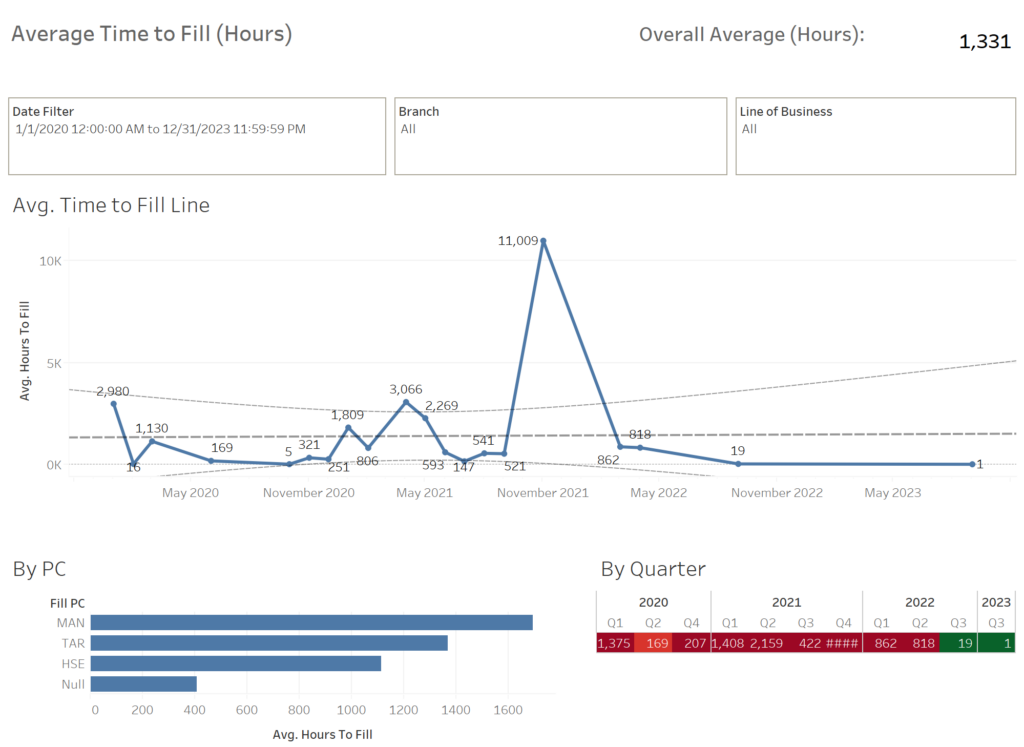
2. Applicant to New Hire Rate/Ratio
The Applicant to New Hire Rate/Ratio shows the number of applicants that were hired. If you have a low Applicant to New Hire Rate/Ratio, that can determine that the quality of the candidates applying is not good or they are not the right fit. If this is the case, you may need to reevaluate your job descriptions and marketing materials, so you receive more candidates that are the right fit.
A low Applicant to New Hire Rate/Ratio can also indicate how well your recruiters are following up with applicants. If some applicants are never followed up with, this can be the problem in your Applicant to New Hire Rate/Ratio. Ideally, you should hope to hire 70% of the applicants that are coming in. To get to this percentage, it’s important to both evaluate the candidates that are coming in and follow up with these candidates. This staffing metric is another great way of estimating your overall candidate pipeline, and forecast what your upcoming recruitment efforts will produce.
3. Cost Per Hire
Cost Per Hire measures the average cost to hire a candidate. This can include money spent on job boards, advertising for a position, onboarding the candidate, etc. Your Cost Per Hire can help determine the effectiveness of the money spent hiring a candidate. If you notice you have a high Cost Per Hire, see what costs can be eliminated. Perhaps you don’t have to advertise on a certain job board that isn’t bringing in quality candidates or you don’t need to ask candidates for drug tests if you are not placing them on an assignment yet. Measuring your Cost Per Hire can help you invest in areas that are most important for hiring a candidate and it can also help eliminate unnecessary costs. From a financial perspective, this is another critical staffing KPI, and will help you better understand your profits and losses on candidates and roles at large.
Placement Success
After you evaluate your recruitment effectiveness, it’s time to look at your placement success. Overall, how successful are you at placing candidates? From the candidates that you hire, how many are showing up on the assignment? Let’s first start with the Placement Rate.
4. Placement Rate
The Placement Rate is critical for determining the rate at which you are successfully placing candidates. If your placement rate isn’t at the percentage you want it to be, then it is an indicator that you are having trouble finding the right candidates to fill positions. A helpful report to pull in this scenario would be a Source to Hire report. This will show you the number of candidates that are being hired from each of your sources. It will give insight into which sources are effective (and should be focused on) and which ones you should eliminate. Some other areas to look at if your Placement Rate is low:
- Marketing and Job Descriptions: Are you not finding candidates because the job descriptions aren’t enticing enough or not attracting the right candidates?
- Resume Submittals: Are you submitting enough resumes and candidate options to your clients?
- Candidate Quality: How are the candidates you are submitting? Are they the right fit?
- No Shows: Are your candidates not showing up to work? If so, what can you do to further ensure candidates show up on their first day of work?
- Time to Fill Too Long: Is it taking too long to fill positions and your client is filling the position before you find someone? If this is the case, it’s time to look back at your Time to Fill and see how you can quicken your hiring process.
These are just a few factors that could affect your Placement Rate. Having a high Placement Rate is important for every staffing business because it helps determine how much money you are bringing in. If the placement rate isn’t as high as you want it to be, see why you aren’t finding the right candidates to fill positions and where things might be going wrong.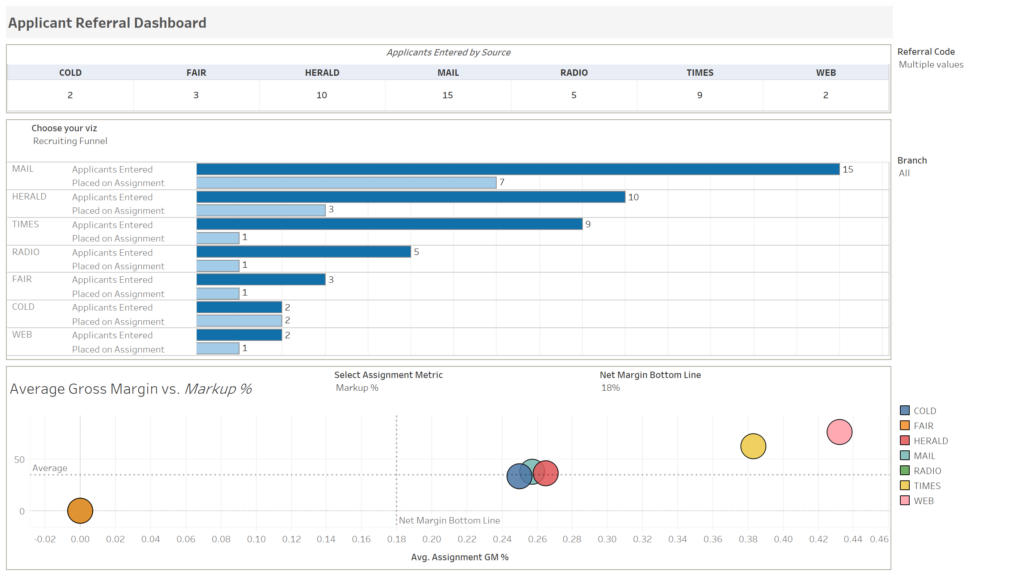
5. New Hire to Assignment Rate/Ratio
The New Hire to Assignment Rate/Ratio measures the rate/ratio that candidates are showing up to the assignment compared to the number that were hired. A low rate/ratio indicates that candidates are ghosting you when it comes time to start the assignment. One reason could be that the candidates aren’t qualified, so they don’t show up to work. If this is the case, then you must look back and see why these candidates are being hired in the first place.
If the candidates are qualified, but just not showing up to the assignment, then you might need to look at solutions to encourage candidates to show up to their assignment. This could mean follow-up texts and check-ins leading up to their first day of work or an incentive of some kind that rewards employees for attendance. There are a number of ways to work on improving this staffing KPI, which gives flexibility in your approach, but it’s crucial to ensure that this number stays at a reasonable and workable level.
Candidate and Client Satisfaction
The next set of staffing agency KPI’s that should be monitored are related to candidate and client satisfaction. Measuring candidate and client satisfaction rates lets you see how happy candidates and clients are with your service. This can also be used as a tool when marketing to potential clients and candidates.
6. Client Satisfaction Rate
Your Client Satisfaction Rate measures how happy your clients are with your services. The best way to measure this would be through a Net Promoter Score (NPS). A Net Promoter Score is a standard across industries that measures customer loyalty. This can be measured through surveys that your company conducts or through a third party. To measure your NPS score, ask clients on a scale of 0-10 how likely they are to recommend your business. Responses should then be organized by Detractors (0-6), Passives (7-8), and Promoters (9-10). From here, take the number of Promoters and subtract the number of Detractors. Divide this number by the Number of Respondents and multiply it by 100 to get your NPS Score. According to our partner Sense, an NPS score above 45 is excellent, a score between 24 and 44 is good, and a score below 24 needs improvement.
Your NPS score will not only tell you how satisfied your customers are, but it’s also an indicator of how loyal your customers are to you. If your NPS score is low, another survey could be conducted to gather client feedback to see where improvements need to be made, or within the initial survey you can have a place for feedback.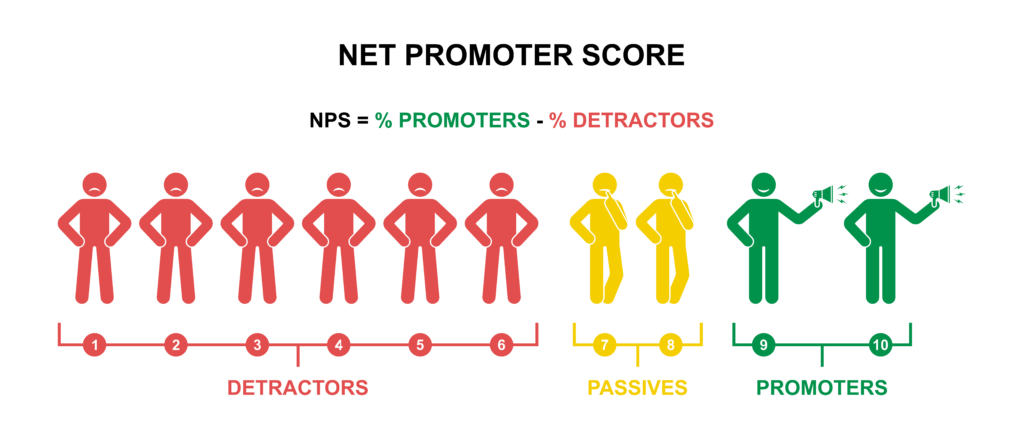
7. Candidate Satisfaction Rate
Candidate Satisfaction Rates are also important to determine how happy candidates are with your services. It also shows how likely they are to continue to work for you. Just as an NPS score can be conducted for your clients, the same can be conducted for your candidates. NPS surveys can even be sent out via a text message to candidates.
As with the Client Satisfaction Rate, follow-up questions or surveys can also complement the NPS Survey to gather more feedback on what candidates like about their experience and what can be improved. The satisfaction of candidates is every bit as crucial of a staffing metric as the client satisfaction rate, so be sure to balance these where possible.
8. Employee Turnover Rate
Your Employee Turnover Rate is a way you can measure employee satisfaction and the quality of hires. The Turnover Rate measures the rate at which employees leave an organization over a given period. Turnover is important for assessing employee retention and stability. A low turnover rate indicates high employee satisfaction and a more stable workforce. A high turnover rate, on the other hand, can signify low employee satisfaction or poor quality of hires.
Keeping track of your Turnover Rate will provide key insights into the employees you are hiring and the ability to retain employees. Your Turnover Rate can also be an important staffing KPI when marketing to potential customers. A low Turnover Rate is a strong selling point when trying to gain new business.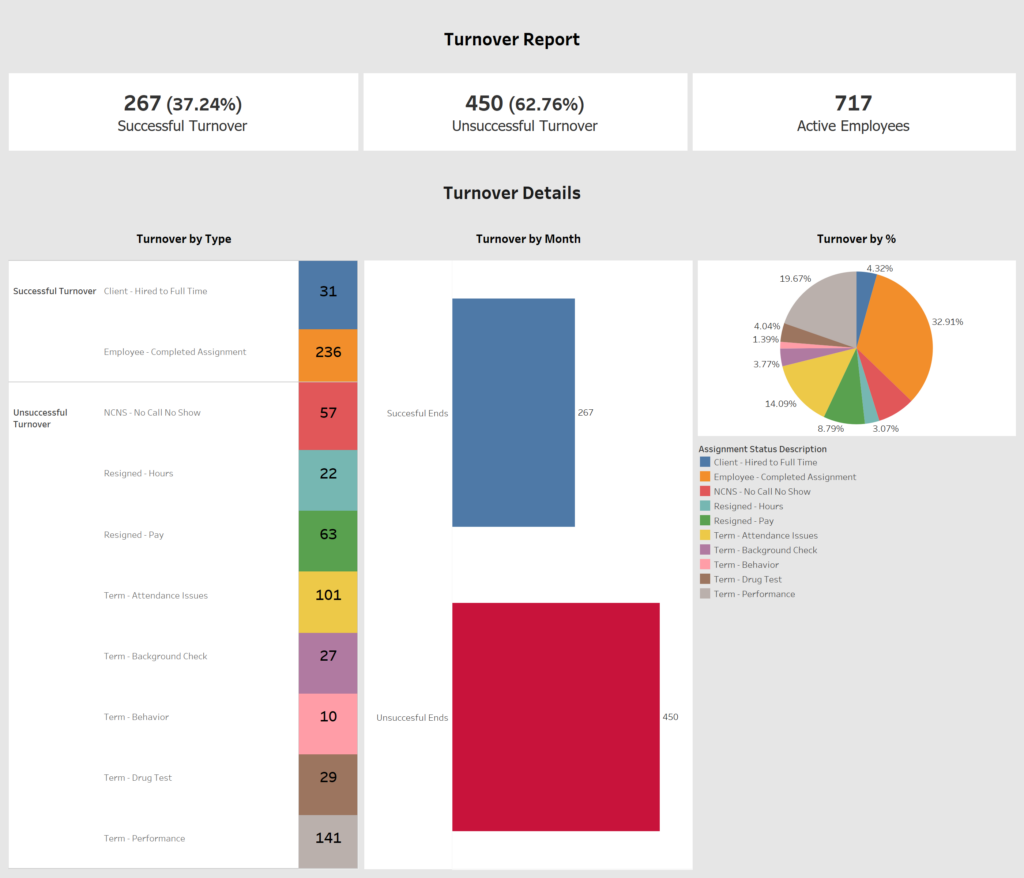
Financial Performance
The most critical KPIs measure financial performance, specifically your Gross Margin. Everything else can seem good, but if you don’t have a healthy Gross Margin, then that will cause financial problems. Gross Margin can be dissected and compared in many ways. We will highlight a few key Gross Margin KPIs below.
9. Gross Margin Percentage
Your Gross Margin Percentage is one of the most important ways to determine how your business is performing. Your Gross Margin Percentage is the percentage of profit you are making from your total sales. You can look at your overall Gross Margin Percentage from your total sales to see a bird’s eye view of the business. You can also break it down more to see how individual areas of your business are performing. For example, you can look at Gross Margin by Branch, Line of Business, Industry, and even by Client. Not only looking at your overall Gross Margin, but diving into specific areas of your business, will help you see which areas are performing well and which areas need improvement.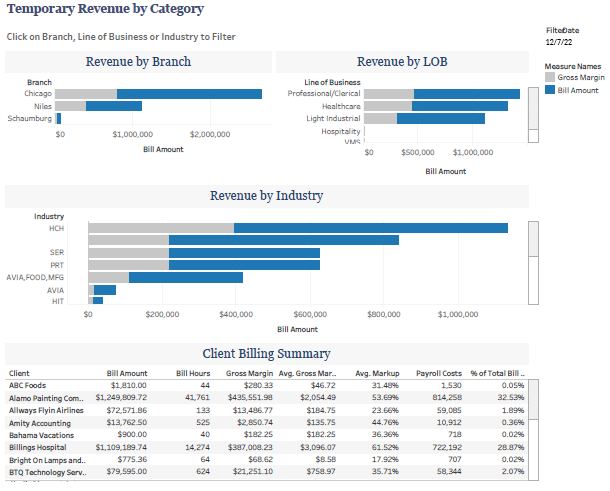
10. Gross Margin Per Employee (Percent and Dollar)
The last important staffing agency KPI to measure is your Gross Margin Per Employee. This will provide an immediate snapshot of how much money you are making with each employee. This can be seen from both a percentage standpoint and a dollar-per-hour amount. These staffing agency KPIs will provide insight into the profit you are making per employee. A low Gross Margin Per Employee will tell you that you might need to go after different businesses, or you need to price your business differently, so you are bringing in more profit.
It’s important for staffing businesses to have a target Gross Margin Percentage Per Employee and a target Gross Margin Dollar Per Hour Per Employee.This target goal will help your business stay profitable. If you are working with a potential client, but the gross margin won’t meet your target, then you won’t be able to do business. Note that your ATS may have a built-in Gross Margin Calculator to make these calculations easy when putting together offers. See if a tool like this is available to help you calculate and manage your Gross Margin.
How to Measure and Analyze These KPIs
You now have your top 10 KPIs that every staffing agency should monitor. How can these KPIs be measured though? Your Applicant Tracking System (ATS) is the place to start. All activities are tracked within your ATS, so from your ATS, you might be able to pull reports and see insights into these staffing KPIs. If you are not familiar with measuring these KPIs in your ATS, reach out to your ATS provider to see what reports are available and how you can track these key performance indicators. There may also be data visualization tools available that integrate with your ATS which could help build reports that visualize your data.
The other important component to measuring KPIs is analyzing them often. Whether you look at these KPIs daily, weekly, or monthly, find a regularity that works for you. Metrics will constantly be changing, so the more you can stay on top of your staffing metrics, the better business decisions you can make. If you see that something is not working, don’t be afraid to change courses and try something new. This is what ultimately will help your business continue to grow.
The Power of KPIs in Staffing Agencies
In this article, we reviewed the top 10 KPIs every staffing agency should monitor. These KPIs help measure recruitment effectiveness, placement success, candidate and client satisfaction, and financial performance. These areas are critical to a successful and growing staffing business. Once you begin measuring your staffing agency KPIs, review them regularly and use them to make strategic decisions. The power of KPIs is in your hands!
Ready to begin leveraging these top 10 KPIs? Reach out to Ultra-Staff EDGE Staffing Software and see how you can effectively track, monitor, and analyze your KPIs with an all-in-one staffing software solution.

